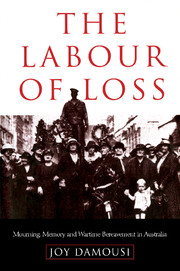Introduction
Published online by Cambridge University Press: 06 July 2010
Summary
‘No event has ever destroyed so much’, wrote Sigmund Freud a year after the outbreak of the First World War, ‘that has confused so many of the clearest intelligences, or so thoroughly debased what is highest.’ This war, he observed,
tramples in blind fury on all that comes in its way as though there were to be no future and no peace among men after it is over. It cuts all the common bonds between the contending peoples and threatens to leave a legacy of embitterment that will make any renewal of those bonds impossible for a long time to come.
It is the bonds that war so effectively severs – bonds that are our most intimate and fundamental – that are the subject of this book. I attempt to explore how mothers, fathers, widows and soldiers dealt with the grief that resulted from the deaths during and immediately after the two world wars. My starting-point is a psychological and emotional one. I examine the process of mourning and the expression of grief, drawing on the understanding that bereavement is ‘the objective situation of loss’, grief is the psychological and emotional response to loss, and mourning is ‘expressive of grief’. Within this context, my study is concerned not only with the psychological strategies that these groups adopted to cope with death, but also examines the cultural and social context of these experiences and thus considers the ways in which grief and loss, like notions of sacrifice, have a history.
- Type
- Chapter
- Information
- The Labour of LossMourning, Memory and Wartime Bereavement in Australia, pp. 1 - 6Publisher: Cambridge University PressPrint publication year: 1999

